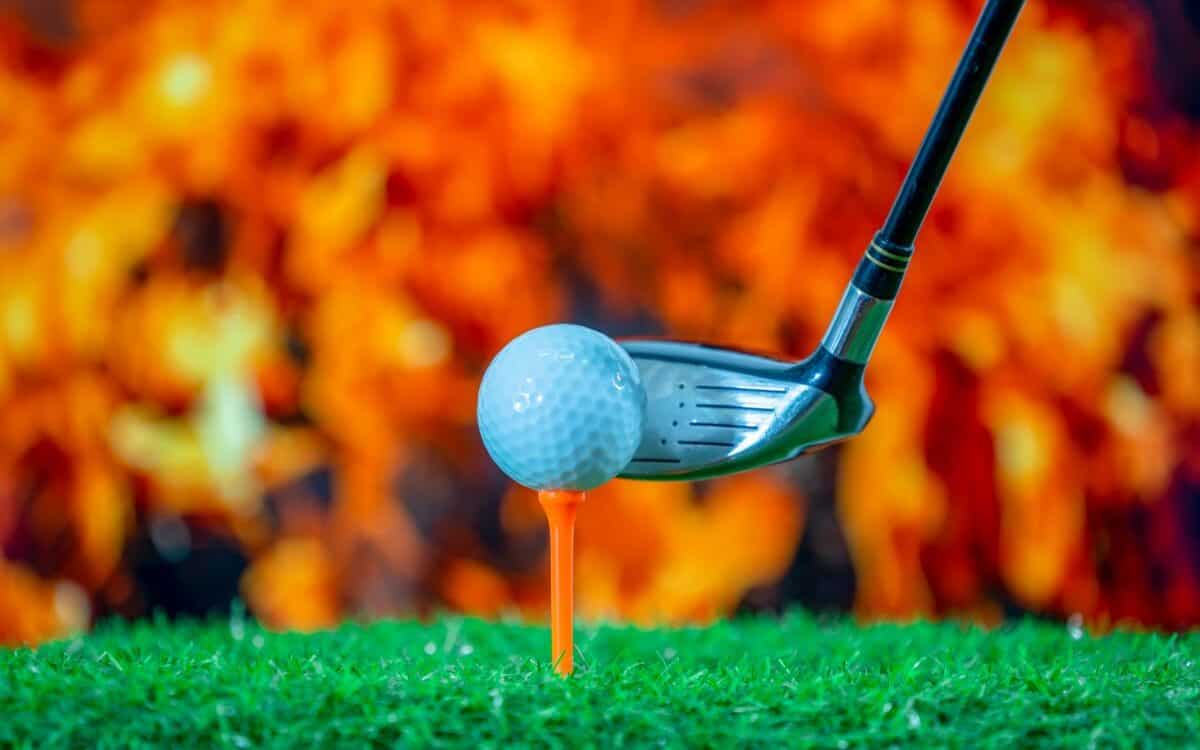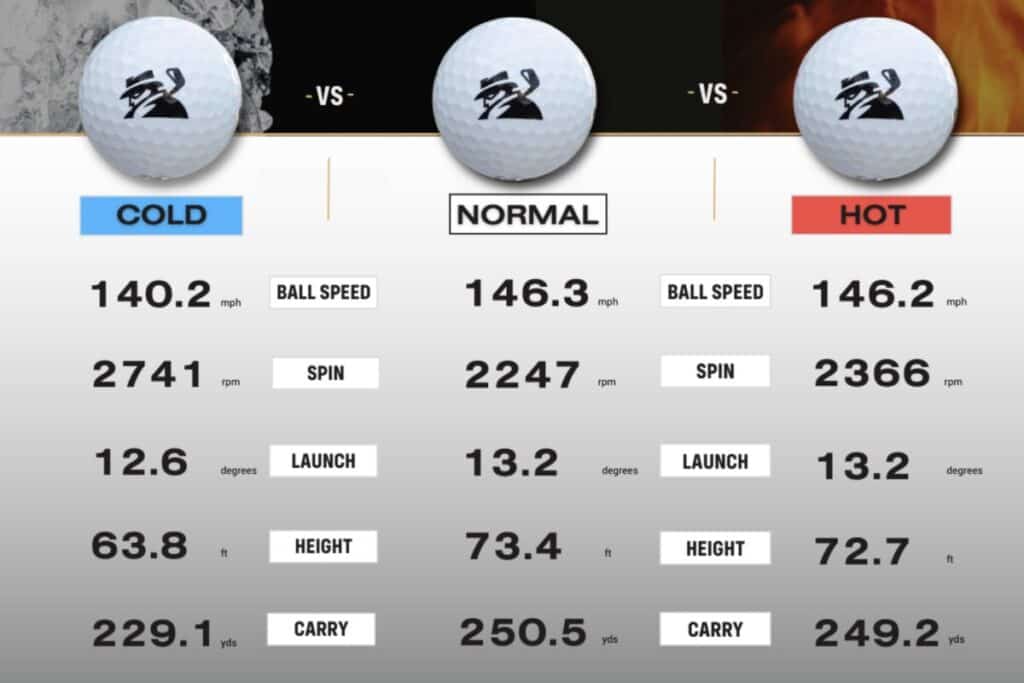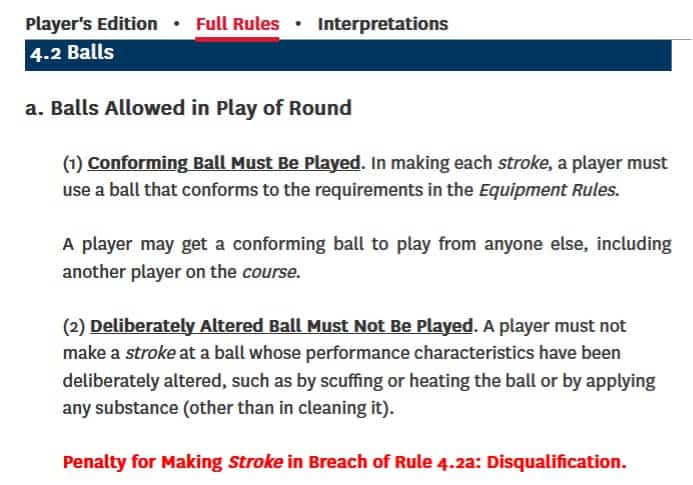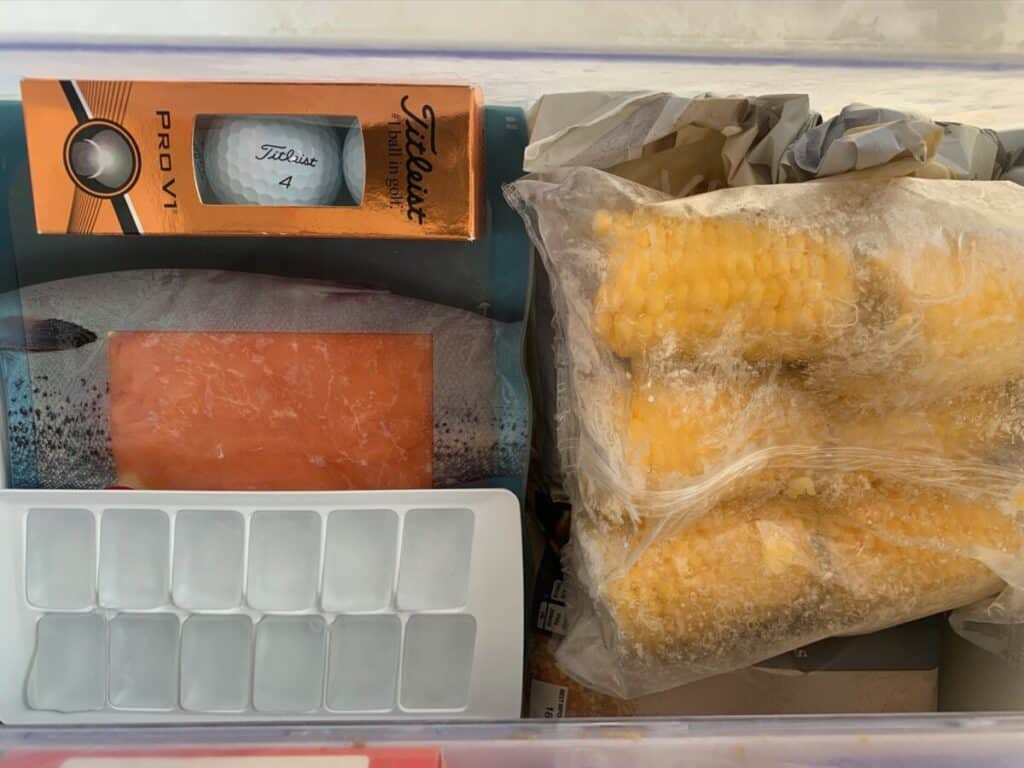Do Heated Golf Balls Go Further? Keep Them in the Room!

If you have played golf for any length of time and especially in certain locations or times of the year you will have been faced with playing in cold temperatures.
Now most golfers already know that a golf ball will not fly as far in the cold but players often wonder whether there are easy things you can potentially do to their equipment to minimize the effect the weather has on your golf.
And one of these relates to the golf ball and whether simply by heating it and keeping it warm for your round you can maintain your distance or even get a few extra yards by doing the same thing in regular conditions.
Warm or heated golf balls can carry up to 21 yards further than golf balls that have been kept in freezing conditions. They do not however go further than balls that are at a normal room temperature of approx. 20ºC (68ºF) and indeed heating a ball by artificial means during a round would lead to disqualification.
There is clearly not a lot you can do about the weather’s scientific effect on the distance you hit the ball.
However being aware of any small things you can do about the elements you can control when playing in different conditions, especially cold ones, can undoubtedly help your scores.
And one of the things you can control is the condition of the golf ball you are playing and knowing how it performs in varying temperatures!
Does the Temperature of a Golf Ball Affect Distance?
When it comes to assessing the impact of varying temperatures on golf ball distance it is important that we initially distinguish the two factors which separately affect how far a ball goes in the heat versus the cold.
One factor is the temperature of the air – which we have already covered in another post you can check out here – but the temperature of your golf ball is another one and it is this factor that we focus on here to assess its separate impact on distance and whether simply by using a hot or cold golf ball you can maybe gain an extra few yards.
The answer to this however is unlikely to be a surprising one.
The temperature of a golf ball does affect distance. Cold golf balls do not carry as far as normal room temperature balls by up to 21.4 yards when hit at 100mph swingspeeds according to MyGolfSpy robot tests. Hot golf balls go further than cold ones by a similar distance but not further than those kept at room temperature.
For MyGolfSpy’s testing experiment they left a set of golf balls exposed to the Arizona heat and compared the performance of these ‘hot’ golf balls to a sample of cold ones which they left in the freezer for about six hours.
And as we can see from their results below they found that exceptionally cold conditions can significantly impact golf ball performance.

Not only did they see a 6mph ball speed and 500rpm spin loss with the 9º degree driver used in the test but most importantly for our purposes noted a reduction of a huge 21 yards of carry distance compared to the ‘normal’ room temperature balls their robot hit.
[Editor’s note – One of the advantages of robot testing (and one of these robots will set you back a cool $250k!) is that it helps to ensure consistent and reliable data as these machines are able to hit the same spot on the club face with highly accurate precision every time!]
But what is perhaps more interesting is the comparison results between the ‘normal’ room temperature ball their robot hit shots with – roughly 20ºC / 68º F – versus the ‘hot’ golf balls which had been left out in the baking sun all day.
And as the data above also shows while ball speed was comparable and the ‘hot’ balls spun slightly more on average resulting in them flying just a bit lower their average carry distance was actually 1.3 yards down on the ‘normal’ room temperature golf ball.
So as a general rule while warming golf balls does indeed help to ensure they do not sacrifice the 21 yards of distance freezing cold golf balls lose by comparison, heating them beyond room temperature does not deliver any noticeable distance benefits according to MyGolfSpy’s robot testing.
Indeed their test suggests heating golf balls excessively will lead to a slight distance loss rather than gains compared to balls kept at normal room temperature.
And the reasons for aiming not to mess around with the temperature of a golf ball outside its normal limits at room temperature are related to the coefficient of thermal expansion.
Now we are not planning for a moment to delve into the Ph.D level science required to fully understand this but the brief summary is that materials expand or contract depending on the temperature and as a result their properties and how they behave are also affected.
If a golf ball gets too cold for example its materials can lose some resiliency resulting in reduced ball speeds off the club face.
As a golf ball gets warmer though the rubber materials used to make them respond better, as the heat gives them more elasticity, creating a ball that comes off the club face with more speed, and that therefore bounces more and travels longer.
Heat that golf ball too much and to excessive amounts however and you will get back into resiliency issues as the properties of the golf ball change beyond what they were designed for.
“When the golf ball gets colder, it can lose a few miles per hour in ball speed which can mean distance loss due to speed … The optimum temperature range is 70º to 90ºF (21º to 32ºC). At 40ºF (4ºC) temps the ball can slow down and be shorter by 5 to 10 yards. But the balls are not 40ºF when played. It takes a while for them to completely get to 40.”
Dean Snell, senior director of R&D, Snell Golf talking to GolfDigest
So the short lesson to be taken from this is that golfers need to at least think about where they are storing their golf balls before a round.
Leaving them in the garage or in the trunk / boot of your car may not be the best idea as if you arrive at the first tee with golf balls a lot colder than room temperature you are likely going to be giving up some distance straight off the bat.
Also, if it’s cold, and you regularly store your golf balls in a potentially freezing cold place, like a garage or your car, the higher compression balls will harden. And that makes them less resilient.
[Editor’s note – For a full breakdown of how conditions, including the wind, altitude, temperature, humidity and even slopes on the course, can affect golf ball distance check out our article on this topic here.]

Is It Even Legal to Warm Golf Balls? Intention is the Key
Now that we know that cold golf balls do not go as far as warmer ones, in part because of the temperature of the golf ball itself, it would seem to make sense for all golfers therefore to ensure they keep their golf balls warm and as close to room temperature as possible throughout their round.
That may be easier said than done when you are playing in especially cold conditions but there are multiple ways you could do it.
However before we get to them we need to first check whether it is even legal to warm up golf balls before or during your round.
Golf is notorious for its rules and for ensuring no unfair advantage is gained by any player at any time but do the rules also extend to cover whether you can heat golf balls before and during your round?
Rule 4.2 a. (2) of the Rules of Golf states that a golfer can not ‘deliberately’ alter a ball’s characteristics by ‘heating the ball’ during play. Using a golf ball warmer to heat a golf ball while playing a round would therefore result in disqualification but heating golf balls ‘before’ your round by whatever means is ok.
Like many rules in golf however they are open to interpretation and what could be determined as ‘deliberate’ can potentially be open to debate.

Would keeping your ball in your warm pocket between holes be considered an attempt to deliberately warm your golf ball for example?
And what about golfers who suffer from arthritis or other medical conditions who find it helpful and sometimes necessary to keep a hand warmer in their pocket to stop their hands from hurting in cold conditions?
In such instances the rule book itself does not provide a definitive answer however when this subject was raised to Golf.com’s rules experts recently the consensus came back as follows.
The safest course of action for a player who keeps a hand warmer in their pocket during a round is to not place any of the balls they use in the same pocket as they keep the hand warmer as this ‘could’ lead to playing partners claiming the heating was ‘deliberate’.
If a ball was ‘accidentally’ placed in the same pocket as the hand warmer during a hole however Golf.com’s rules experts’ proposed simply swapping that ball for another at a cost of a ‘general penalty’ for an impermissible substitution to avoid disqualification.
But If the mistake happened between holes they said you could do the same swap for another ball from your bag without penalty.
The act of simply putting your golf ball in any pocket which didn’t have any hand warmer or other ‘artificial’ device to heat it up however is perfectly fine.
As such it is probably a good idea to rotate a couple of balls hole-by-hole when playing in the cold, playing with one while keeping the other in your jacket or trouser/pants pocket.
Tests have shown that golf balls very quickly adopt the temperature they are exposed to but at the very least it is not going to do any harm especially for the first shot you play on any hole.
Before your round though you are free to heat your golf balls as much as you like though and by whatever means you want.
You could even stick it in the microwave in you wanted but as we will see when it comes to looking at your options for how you can warm up golf balls below that may not be the best idea!

How Do You Warm up Golf Balls? Play it Safe!
Tests comparing how far hot vs. cold golf balls go make it clear that it is recommended to use ones that are as close to room temperature as possible.
It is therefore best to avoid leaving your golf balls out in the cold whether that be in the garage, the trunk/boot of your car, or just lying on the putting green before you head out.
But if you do find yourself due to play with cold golf balls we wanted to look at what your choices are for warming them up.
The options for warming up golf balls depend on when they are being heated up. Before play artificial devices such as radiators, golf cart heaters, pocket hand warmers or simply warm towels can be used. During a round these would result in disqualification so then keeping a ball in your pocket is the best option.
Because a player cannot use an artificial device after they have teed off at the first therefore we can see there are really not many options available to golfers wanting to warm up their golf balls during their round.
You could stick them under your armpit or sit on them like incubating an egg but these aren’t really practical!
“It’s a common misconception that you should switch to a lower compression golf ball in colder conditions. This practice is meant to compensate for the increase in compression that occurs when a ball gets colder. If you play with balls that are at near room temperature as we suggest [however], this becomes a moot point.”
Zach R, Titleist Team Staff
However because it doesn’t matter what you use to warm up a golf ball before you start playing there are plenty of things you can do to try and ensure your ball is not considerably colder than room temperature by the time you hit the first tee.
Whatever method you choose though – whether that be simply leaving them under the radiator in your room or at the golf club prior to playing, or wrapping them in a towel that you have soaked in very hot water from the tap for 30 minutes or so – just beware of going to the extremes!
Warming up a golf ball in a microwave for example is going to heat it to an extreme temperature it is not designed for. This will change its physical properties and negatively affect its performance, including how far it goes. Indeed tests have shown excessive heating of a golf ball in the microwave will lead to it melting.
As with anything microwaving things that are not intended to be microwaved tend not to lead to good results and golf balls, or even towels to then wrap golf balls in, are two such things that are probably best avoided!
For the best and most consistent results just try and keep your golf balls, by whatever means you can within the rules, as close to room temperature as you can irrespective of the conditions you find yourself playing in.
As for a lot of things room temperature is the most sensible way forward!
Final Thought
The precise amount of distance lost due to playing golf in cold weather is always difficult to state because temperature affects how far golfers can hit the ball in multiple ways.
As we have already run through above when the golf ball and golf club are colder the transfer of energy is not as efficient, so the ball speed and therefore distance will be less.
But it is the cold air that does the most damage from a distance perspective rather than the ball itself.
Cold air is denser which means more drag on the golf ball and less distance as a result irrespective of whether your ball is warm or cold.
It’s easy to say keep your ball at ‘room temperature’ as much as you can but on a cold frosty morning when your ball is lying in the fairway or rough for a few minutes you just can’t keep that ball warm.
You can do the best you can by arriving at the first tee with a warm golf ball and alternating balls stored in your warm pocket (without a handwarmer!) throughout the round but what will make the most difference on any given day is playing the same ball you always use and being aware of whether it is hot or cold.
Then if you know how it behaves in both states you can make the necessary allowances for it.
Other top posts related to this article
- Do All Golf Balls Go the Same Distance? Physics First
- Do Golf Balls go Bad? Grab a Dime to Check!
- Do Certain Golf Balls Go Further? Brand and Cost Considerations
- How Do Pros Hit the Ball So Far? It’s Not About the Equipment!
- Do All Golf Balls Go the Same Distance? Physics First
- What Affects Golf Ball Distance? Beware ALL the Uncontrollables!
- Why Don’t Pros Use Coloured Golf Balls? It’s Not Black and White
- What Golf Balls Do LPGA Players Use? Top 50 Player Breakdown
- What Golf Balls Do the Pros Use? Top 100 PGA Tour Players Breakdown
- Do Distance Balls Go Further? Marketing Matters
- What Determines Driver Distance? Skill Triumphs Over All!
- How Far Should You Hit a Driver? FULL GUIDE By Age, Handicap etc.
- Ideal Spin Rate and Launch Angle for Driver? That’s Personal!
- How Far Should Your Ball Speed Go? 100mph All the Way to 210mph!
- How Far Should Your Driver Swingspeed Go? 60 to 120 mph Guide
- How Much Does Driver Loft Affect Distance? Loft is Dynamic Too!
- Where is the Sweet Spot on the Driver Face? Take the High Road
RECENT ARTICLES
LEGAL INFORMATION
This site is owned and operated by Golfing Focus Limited, a private limited company whose registered office is in London, UK. Golfing Focus Limited is a participant in the Amazon Services LLC Associates Program, an affiliate advertising program designed to provide a means for sites to earn advertising fees (at no cost to you) by linking to Amazon.com. Golfing Focus Limited also participates in other affiliate programs with the eBay Partner Network, FlexOffers, CJ.com, Svorn and other sites and is compensated for referring traffic and business to these companies (again at no cost to you).
Our Socials






Leave a Reply